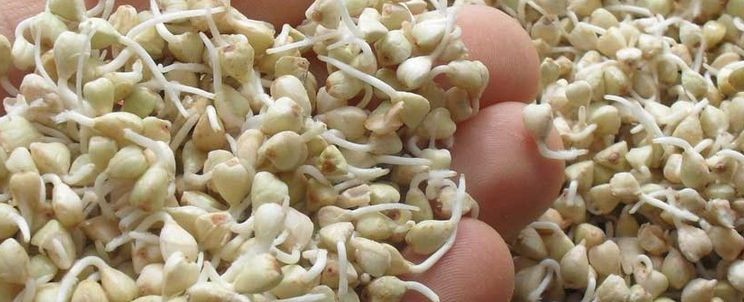Everyone knows buckwheat, whole-grains that are produced from a honey plant with the same name. Although due to the absence of gluten* it is not suitable for baking bread, it is used for baking pancakes, cakes, and even for dumplings, porridge and soups. Buckwheat homeland is North India, where it is called “black rice”.
Typically, the buckwheat that is sold in the stores was processed at high temperatures, and thus is not suitable for sprouting. Only green (not roasted) buckwheat can give sprouts. It is green because the top layer of the husk is removed only, the embryo is not damaged.
Sprouts taste: sweet, with a slight herbal flavor.
Sprouting instructions:
-
Sort, rinse, and soak 3-4 tablespoons of green buckwheat in the Sprouter for 2-4 hours, the grains must be completely covered with water.
-
Rinse with clean water several times (by this time the buckwheat would excrete mucus which you thus wash off), shake to saturate the grains with air, keep wet in the Sprouter for 10-12 hours total.
-
Rinse and shake every 6-8 hours prior to the appearance of sprouts of the desired length.
-
Eat or place in the refrigerator in the Sprouter with air access (but not more than for two days).
Buckwheat, just like flax, excretes mucus during sprouting. It should be washed off with clean water.
The grains of buckwheat contain 10-18% protein, 2.4-3% fat, 59-82% carbohydrates, 12-16% fiber.
It contains phosphorus (up to 330 mg / 100 g), potassium (380 mg / 100 g), calcium, magnesium (200 mg / 100 g), manganese (1.56 mg / 100 g), cobalt (3 mg / 100 g ), boron, silicon, vanadium, iron (8 mg / 100 g), copper, zinc (2.05 mg / 100 g), molybdenum.
Buckweat is rich in vitamins B1 (up to 0.58 mg / 100 g), B2, B3 (4.19 mg / 100 g), B6 (0.4 mg / 100 g), E (0,2-6,7 mg / 100 g), also contains vitamin C and carotene. The amount of vitamin C increases during sprouting from 1.49 to 26.4 mg / 100g.
Buckwheat seeds are superior to all other cultures by the concentration of routine, a bioflavonoid which has the capacity to improve the condition of blood vessels, especially capillaries, strengthening their thin walls.
Sprouted seeds of buckwheat are recommended for the prevention and treatment of various diseases of the blood vessels (atherosclerosis, coronary heart disease, hypertension) and infectious diseases that damage the vascular system (measles, scarlet fever, sore throat, typhuses), to reduce intraocular pressure in cases of simple glaucoma, of varicose veins and hemorrhoids.
It is useful to add it to the diet when treating the radiation sickness, liver and kidney diseases, obesity, diabetes, nose and gums bleeding, the loss of blood.
Below are the most common errors when sprouting green buckwheat:
1. Too much water.
To sprout the buckwheat, put it in the Sprouter’s internal jar, rinse it, and then cover with water measuring 1/2 inch higher than the grains level. Better a little less than a little more.
2. Too long soaking.
If after 2-4 hours (not more!) the water was not absorbed by the grains, it must be drained! If you have to drain a lot of water after this term, then you poured too much of it. Ideally, in 2-4 hours the grains should absorb all the water. Then you rinse the grains. Gently mix the grains by shaking the Sprouter jar and leave for another 10-12 hours.
3. No mixing.
All grains require the same level of moisture and oxygen. Therefore, during the 10-12 hours sprouting try to shake the jar gently at least a couple of times. If the bottom of the jar is too wet, and the top layer dried out, gently mix the grains so that the dry grains went down, and the wet ones were over them.
* Buckwheat contains no gluten, so it can be used by people with gluten intolerance.




Comments:
Off